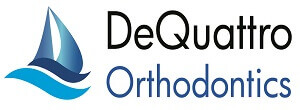Say Goodbye to Misalignments With DeQuattro Orthodontics
At DeQuattro Orthodontics, our experienced Rhode Island dentist, Dr. Frank DeQuattro, and our dedicated team are committed to enhancing the function and aesthetics of your smile. Orthodontic issues can affect more than just appearance; untreated misalignments can also lead to oral health complications over time. If you’re experiencing issues like misaligned teeth or jaw pain, understanding the most common orthodontic concerns is a crucial first step.
We invite you to take control of your smile by calling our Wakefield office at (401) 783-9890 or our Westerly office at (401) 596-2264 to schedule a personalized consultation. Let’s start your journey to a healthier, more confident smile!
Types of Common Orthodontic Issues
A general term for misalignments of the teeth or jaw, malocclusions can impact bite function and overall dental health.
- Overbite: When the upper front teeth excessively overlap the lower front teeth, it can cause jaw discomfort and even damage the lower teeth.
- Underbite: An underbite is when the lower front teeth protrude beyond the upper front teeth, which may affect speech, chewing, and facial harmony.
- Crossbite: This occurs when upper teeth sit inside lower teeth when the jaw is closed. Left untreated, it can lead to gum recession and uneven wear on teeth.
- Crowding: A lack of space in the jaw for all teeth to align properly can cause overcrowding, which may require orthodontic intervention to correct.
- Spacing: Excessive gaps between teeth can impact aesthetics and may affect the alignment of neighboring teeth.
- Open Bite: An open bite is characterized by a gap between the upper and lower front teeth when the mouth is closed, often affecting chewing and speech.
- Midline Misalignment: When the center of the upper front teeth doesn’t align with the center of the lower front teeth, it can disturb the balance of the smile.
Causes of Common Orthodontic Issues
Understanding the root causes of orthodontic issues can help in both prevention and treatment.
- Genetics: Many orthodontic concerns are hereditary. If your family members have dealt with misalignments, you may be more likely to experience similar issues.
- Developmental Factors: Habits like thumb sucking, prolonged pacifier use, and tongue thrusting during childhood can lead to misalignments as the teeth and jaw develop.
- Injury or Trauma: Facial injuries can shift teeth out of alignment, sometimes necessitating orthodontic intervention.
Recognizing the Signs of Orthodontic Issues
Identifying orthodontic concerns early on can help prevent the need for more extensive treatment. If you notice any of these symptoms, it may be time to consult with DeQuattro Orthodontics:
- Changes in Your Smile: Misaligned teeth not only affect your smile’s appearance but can also impact self-confidence. Straightening your teeth can enhance your natural smile and boost your self-esteem.
- Chewing or Speaking Difficulties: If you experience difficulty biting or notice speech clarity issues, alignment problems could be the cause. Addressing these can improve both function and comfort.
- Jaw Pain or Discomfort: Chronic pain in the jaw joints, facial muscles, or frequent headaches can often be linked to alignment issues. Proper orthodontic treatment can relieve these symptoms, improving your daily comfort.
- Uneven Tooth Wear or Damage: Misaligned teeth can wear down unevenly, making them more prone to cavities and fractures. Correcting alignment early helps protect your natural teeth in the long term.
If you or a family member recognize any of these signs, give DeQuattro Orthodontics a call. Early intervention can simplify treatment and make a big difference in maintaining your oral health. Reach out today to schedule a consultation and take the first step toward a healthier smile!
Diagnosis and Assessment
DeQuattro Orthodontics uses advanced diagnostic methods to fully understand each patient’s unique orthodontic needs.
- Orthodontic Examination: A comprehensive evaluation of bite patterns, alignment, and facial structure gives insight into the specific issues at hand.
- X-rays and Imaging: Modern imaging tools like iTero 3D scans allow us to get a clear view of the jaw and tooth positions for accurate diagnoses.
- Treatment Planning: After assessing your orthodontic needs, we’ll create a tailored treatment plan to guide your journey to a better-aligned smile.
Treatment Options
Several treatment methods can effectively address common orthodontic issues, each tailored to individual needs and preferences.
- Traditional Braces: Metal braces provide reliable and precise correction for various orthodontic issues.
- Invisalign and Clear Aligners: These removable aligners offer a discreet, convenient way to gradually align teeth, ideal for those seeking an aesthetic alternative.
- Orthodontic Appliances: Certain cases may require specialized appliances, such as expanders or headgear, to address specific concerns.
- Surgical Interventions: For severe misalignments, surgical options like orthognathic surgery may be necessary.
Prevention Strategies
Early intervention and good oral habits can help prevent or minimize orthodontic issues, especially for children.
- Early Orthodontic Evaluation: An assessment around age seven can identify potential issues early, allowing for timely intervention if necessary.
- Encouraging Good Oral Habits: For children, avoiding thumb sucking and maintaining good oral hygiene can support healthier development of teeth and jaw alignment.
- Adult Orthodontics: Adults, too, can benefit from modern orthodontic options like clear aligners, which provide discreet treatment.
- Retention Phase: After treatment, retainers help prevent teeth from shifting, maintaining the new alignment.
Frequently Asked Questions
While some people are referred by their general dentists, it’s not always necessary. Many orthodontists offer consultations directly.
Orthodontic treatment can sometimes alleviate jaw pain related to misalignments. Persistent pain, however, may require a broader dental assessment.
The orthodontic treatment goes beyond cosmetic improvements. It can contribute to better oral health by reducing the risk of cavities, gum disease, and jaw joint issues. Properly aligned teeth are also easier to clean.
Coverage for orthodontic treatment varies. Many insurance plans cover part of orthodontic treatments, especially for children. Check with your provider for specific details.
Take the First Step Towards a Confident Smile!
Investing in orthodontic treatment is a significant step toward improved oral health and self-confidence. Call our Wakefield office at (401) 783-9890 or our Westerly office at (401) 596-2264 to book your consultation. We proudly serve patients from South Kingstown, Charlestown, Weekapaug, and beyond. Your journey to a healthier, happier smile starts here!


